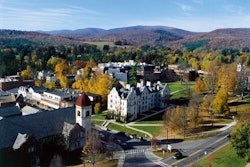When Dr. Ratna Naik was offered the job of dean of physics at Wayne State University, she was reluctant to accept. Coming from a culture that valued silence and the voices of men over women, Naik was afraid of speaking to large groups and wondered if anyone in a department with two women among 30 faculty members would listen to her anyway. After a year, she took the position.
“We have to learn the ways of American culture; it’s OK to speak up in a gentle way,” she said last week at a panel discussion about boosting the number of Asians in administrative ranks, “Breaking Through the Bamboo Ceiling: Asian Americans in Higher Education,” held at WSU.
The bamboo ceiling is a real concern that “does exist for Asian Americans,” said Dr. Yuan Zheng, professor and former chairman of the department of electrical and chemical engineering at The Ohio State University, but in the 30 years that he’s been in the United States, that ceiling “is getting thinner.” For all the Asian American graduate students, there are comparatively few faculty, department chairs or administrators. Part of the reason: Asian Americans are often focused on research, and staying at the top of their fields, rather than advancing into administration.
Still, Dr. Subrata Sengupta, the dean of the College of Engineering and Computer Science at the University of Michigan-Dearborn, has seen the number of Asian American deans increase in the 18 years since he became a dean. He has also seen Asian Americans fill the ranks of some disciplines, like engineering, faster than others.
“Some fields will break the bamboo ceiling earlier than others,” said Sengupta. “But there is a danger of perception being the root of stereotypes,” like the idea that Asians are good at math and science, but not administration or politics.
Now, the key to advancing is to engage with American culture. “As Asian immigrants,” said Zheng, “we must integrate ourselves into the American culture of higher education to break the [bamboo] ceiling.”
Asian Americans are typically prepared academically and have strong values of harmony and respect, said Zheng, but to move into leadership positions, they need to learn how to communicate and voice opinions, reach out to social and technical communities, and spend time in teaching and service. “Americans are enthusiastic in service activities,” said Zheng, “they become leaders in organizations because of that.”
Sengupta sees value in adjusting to the culture you’re working in order to become a leader, “even if that goes against what you usually do.” For example, in Asian countries seniority comes with age, but not in America where ability is most important. Too often, “Asians wait to take responsibility until it’s too late,” he said.
Click here to post and read comments
© Copyright 2005 by DiverseEducation.com


















